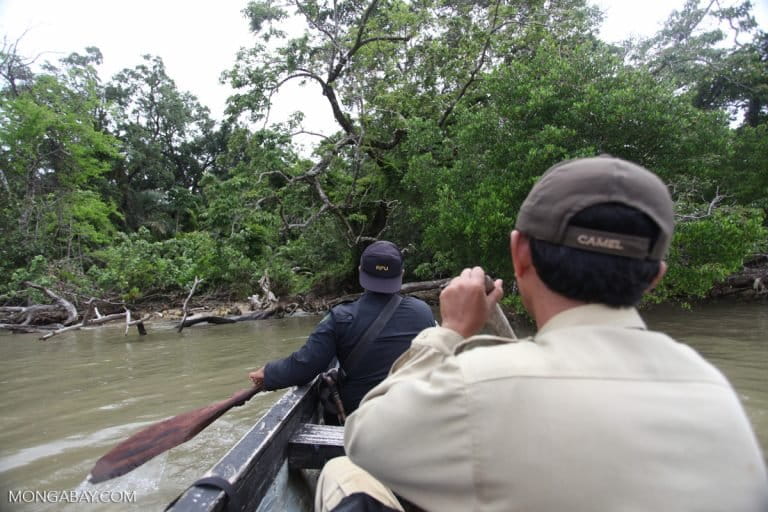PANDEGLANG/JAKARTA, Indonesia — A recent revelation that up to 26 Javan rhinos may have been poached, out of a total population of 70-odd, has come as a major blow to conservation efforts in Indonesia. The still-unfolding case has highlighted flaws in security management at Ujung Kulon National Park, the last place on Earth where this critically endangered species is found.
In June, Mongabay Indonesia conducted a comprehensive investigation, including data analysis, ground checking and discussions with multiple sources in and around the park, to determine how two poaching gangs were able to carry out a killing spree for years in one of the most heavily patrolled and surveilled protected areas in the world. We found strong indications suggesting a key member of the patrol team may have been feeding information to the poachers. The latter, for their part, had access to funding, weapons and hunting expertise.
While some progress has been made in uncovering the methods used by the poachers, many questions remain unanswered, casting the future of the Javan rhino (Rhinoceros sondaicus) into doubt.


Yusup, 53, who heads a local youth organization, lives just 50 meters (160 feet) from the house of Sunendi bin Karnadi, 32, the poaching kingpin who in June was convicted and sentenced to a record 12 years in jail by the Pandeglang District Court. Yusup described Sunendi as a reclusive individual who rarely engaged in community activities.
“This is the first case of its kind,” Yusup told Mongabay Indonesia when we met him on June 13 in his home hamlet of Ciakar, in Pandeglang district, Banten province. He emphasized that none of the members of his youth organization were involved in the rhino poaching.
The case against Sunendi unfolded when the Banten police received a report dated May 29, 2023, about the disappearance of four camera traps from Ujung Kulon. From footage taken by other camera traps in the park, police identified Sunendi; his face was clearly visible and he could be seen carrying a rifle and machete.
One segment of camera-trap footage showed Sunendi aiming his rifle at a rhino from about 15 m (50 ft) away. The rhino appeared to be shot in the stomach. One of Sunendi’s alleged accomplices, Haris, then decapitated the rhino with a machete. According to court testimony, Sunendi later placed the severed rhino horn in a plastic bag and hid it in his rafters at home.
Police eventually tracked down Sunendi and arrested him near a bus terminal in Jakarta on Nov. 26, 2023. They took him back to Ciakar that same day to assist in a search of his house, where they found a Mauser hunting rifle, a revolver, an airsoft gun, and dozens of rounds of ammunition. Indonesia has stringent gun laws; civilian gun ownership is heavily restricted and controlled by the government. Wildlife hunters must obtain a specific license, which requires a thorough vetting process, and must adhere to quotas and guidelines to prevent overhunting. The types of firearms permitted for hunting are limited, and the activity is restricted to certain areas and seasons to protect wildlife populations.
The arrival of the police shocked the entire hamlet, residents told Mongabay Indonesia. The usually quiet, remote area was suddenly filled with heavily armed officers, who blocked residents from leaving Ciakar or even tending to their farms and gardens while police searched for the alleged perpetrators who had already fled into the nearby forest. According to residents who spoke to Mongabay Indonesia, officers found rhino bones and skulls in Sunendi’s house.


Residents say they’d long speculated about what Sunendi did for a living. In the space of less than three years, he amassed a level of wealth unusual for such a small rural hamlet. A recent purchase of a car worth 300 million rupiah ($18,500), far beyond what other Ciakar residents could afford, had raised eyebrows. Rumors spread that Sunendi frequented a sacred site in Ujung Kulon, leading to speculation that his wealth derived from some kind of black magic.
During the trial, however, it was revealed that the true source of his wealth was poaching rhinos and selling their horns. Prosecutors alleged that Sunendi and his brother, Sahru, each led a poaching gang, with six and four proven kills, respectively. Testimony from the accused middleman who connected the poachers to a buyer, and who was later sentenced to four and a half years in jail, revealed that each rhino horn netted the gang 200 million to 525 million rupiah ($12,300 to $32,400).
Sunendi and Sahru come from a family with a history of hunting. Their father and grandfather were respected figures in the village; their father in particular was thought by some to possess powerful magic for hunting animals.
In Ciakar and neighboring hamlets, hunting has long been a tradition passed down through generations. Farmers often carry homemade weapons to the fields to fend off wild boars that frequently invade their gardens. Since the rhino poaching case came to light, authorities have confiscated these weapons from residents.
In the 100 years since Ujung Kulon was established as a protected area, several locals made a name for themselves as rhino poachers. In recent decades, though, many have stopped due to old age, death, or remorse, with some eventually partnering with forest rangers in conservation efforts.
Sunendi’s case marked the first reported instance of poaching in more than two decades, and highlights the vulnerability of Ujung Kulon to rhino poachers. It also raises numerous questions. Spotting a Javan rhino in Ujung Kulon is challenging due to the animal’s sensitivity to sound and scent. Only a few people have ever seen them in the wild; in the 1980s, it took renowned wildlife photographer Alain Compost years to capture a photo of a Javan rhino.
So how did Sunendi and Sahru’s gangs know where to find the rhinos and carry out their massive poaching operations from 2022 to 2023?
Leaked rhino locations
Ciakar hamlet is part of the village of Rancapinang, which borders Ujung Kulon National Park to the east and stretches along parts of the park’s southern coast. Unlike other human settlements that are separated from the park by the foothills of Mount Honje, Rancapinang has sweeping access to the park, both by land and sea. For years its position meant it was the traditional gateway for pilgrims heading to the Sang Hyang Sirah religious site on the park’s western edge. That also made it an entry point for loggers, bird hunters, and lobster and fish poachers to plunder the park’s biodiversity.
Sunendi and Sahru’s gangs were among the encroachers. To cover their tracks, they would hide supplies and equipment, including their weapons, by the trailside.
According to court records and news reports of the proceedings, Sunendi had a summary sheet of individual Javan rhino data from camera traps spanning 2010-2023. He also had a map of park guard entry and exit points; maps showing the distribution of Javan rhinos from 2020-2023; data on which rhinos had died and where; and a flash drive containing these and other data on the rhinos.
Prosecutors made the case that this wealth of information was instrumental in Sunendi’s operations. In Mongabay Indonesia’s investigation, a source told us the data were leaked by an individual identified only by the initial “M.” According to the source, who spoke on condition of anonymity, M was recruited in 2009 to serve as an auxiliary member assisting with patrols by the Rhino Protection Unit (RPU), a team administered by one of Ujung Kulon National Park’s NGO partners. (In a letter sent to Mongabay Indonesia after the original Indonesian version of this article was published, the park acknowledged the existence of M, but denied that they were either a full-time or honorary staff member.)
M previously worked as a wildlife poacher, according to a resident familiar with the individual, who spoke on condition of anonymity. The resident said M went missing shortly after the poaching case came to light.

Mongabay Indonesia’s source indicated that M, originally from Ciakar hamlet and related to Sunendi, had moved to Cegog hamlet after marriage, still within Rancapinang village. This information was corroborated by another source who had worked closely with M at the national park in the rhino monitoring division. The second source, also speaking on condition of anonymity, said M was strongly suspected of supplying Sunendi and Sahru’s gangs with information regarding the locations frequented by Javan rhino hideouts.
This source also said M had trained Sunendi in his poaching operations. To avoid detection, Sunendi occasionally wore a mask, face cover, and a uniform similar to that worn by Ujung Kulon’s patrol officers. The source said M would have tipped off Sunendi about the rhinos’ solitary behavior, except during mating or when a mother is with her calf, which likely helped Sunendi map out the movements of individual rhinos.
According to the source, the rhino killings began in 2018, with the discovery of the body of a male known to park officials as Samson, in the Karang Ranjang area on Ujung Kulon’s southern coast. The rhino had a skull puncture, indicating it had been shot. But in a public announcement, park officials insisted the rhino had died of natural causes. The source suggested a possible cover-up of known poaching activity.
The source’s account aligns with the findings of a report by the Auriga Nusantara Foundation, a conservation NGO. It highlighted questionable practices in the Indonesian government’s official population count and an increase in reported poaching activity in Ujung Kulon. Auriga’s findings also suggested that Samson died from being shot in the head. However, Ujung Kulon National Park officials insisted the hole in the rhino’s skull was made by a sharp bamboo-like plant that’s found in the park.

The second source also alleged that Sunendi had learned from M about gaps between rangers’ schedules at Ujung Kulon, which likely helped the gang enter the park undetected either from the south by sea or from the east by land.
According to the park’s monitoring policies, each guard post typically operates in two shifts, rotating every 15 days, with one shift led by a unit leader and two members. However, the source said these posts were often left vacant, adding that some of the watchpoints along the eastern part of the park were damaged or abandoned, and no longer operational. These security gaps, the source said, had been there long before the reported death of Samson.
The source also said that patrol officers would occasionally be present when specific activities were taking place, such as camera-trap installations or operations to clear invasive plants.
Following Samson’s death, poachers increasingly targeted the core areas of Ujung Kulon National Park. Numerous human tracks were discovered around Javan rhino habitats, particularly areas where the rhino presence had been recorded.
In one example, the source said that at least two people were suspected to be on a stakeout for a single rhino. When several members of the monitoring team wanted to report suspicions of rhino poaching, M was said to threaten them, according to the source.
During an effort to map rhino wallows, the mud pits where rhinos typically wallow to stay cool, the source said patrol officers had found a hunting blind, camouflaged and about 7 m (23 ft) up in a tree deep in the forest. That put it out of range of the rhinos’ keen sense of smell. Just 10 m (33 ft) away was one of the wallows favored by the rhinos.
Such technical information about the rhinos and their habitat are typically exclusive to rangers, according to the source.

The source also described another incident during a field patrol with M, when the team heard what sounded like three rifle shots near one of the patrol posts. M instructed the team members to stay back while he investigated the noise alone, according to the source.
In the days following Sunendi and his gang’s arrest by the police, M’s behavior became increasingly erratic, the source said. When police conducted mobile phone searches, M appeared to panic and tried unsuccessfully to retrieve his phone, which an officer had already taken, the source said. Since then, M has vanished: he stopped showing up to work, prompting inquiries from his superiors. To date, his whereabouts remain unknown.
During a press conference at the Banten provincial police headquarters on June 24, Ardi Andoni, head of Ujung Kulon National Park, denied that the poachers had been helped by park insiders leaking data. He said some of the information they had was available online, and that the documents found in their possession were only minutes from conservation awareness seminars hosted by the park agency.
In a written response to Mongabay Indonesia, Ardi said the allegedly leaked documents — a map of patrol routes, a map of rhino distribution from 2020-2023, a folder of rhino deaths, and a flash drive of other rhino data — were evidence submitted by an expert witness during Sunendi’s trial. However, the court said otherwise; the panel of judges stated at Sunendi’s sentencing on June 5 that the documents were among the evidence seized at his house.
In the field
All of the rhino poachers are residents of Rancapinang village, according to police and court records, and were recruited from people close to Sunendi and Sahru. Sunendi led what was known as Group I, with six men under him; Sahru led Group II, where he was also in charge of six men.
In raids between May 7 and 16, police and conservation authorities arrested five of the men; the remainder are still at large, according to an official statement published on June 12.
In the field, Sunendi and Sahru were typically responsible for shooting the rhinos, while the other members cut the corpses up with machetes. The poachers were connected to buyers via an intermediary in Jakarta, Yogi Purwadi. Between March 2020 and December 2022, Sunendi sold four rhino horns via Yogi, meeting in Jakarta for each transaction, according to court documents. He split the proceeds with his gang members.
In April 2020, Sunendi received 260 million rupiah ($16,100) in cash from Yogi, who, together with a colleague, Erik, acted as an intermediary for a Jakarta-based buyer named Liem Hoo Kwan. In December 2020, Sunendi brought another rhino horn to Yogi, which Willy bought for 315 million rupiah ($19,500) in cash.
In 2022, they met twice more: That August, Sunendi sold a horn via Yogi for 525 million rupiah ($32,500), with the money wired to his bank account, and in December, Sunendi sold a fourth horn for 200 million rupiah ($12,400) in cash. Yogi received a commission from Sunendi of 5 million rupiah ($310) for the first three transactions and 2.5 million rupiah ($155) for the last one. The Pandeglang District Court on July 28 sentenced Yogi sentenced to four and a half years in prison and fined him 100 million rupiah ($6,200).

The mystery of the missing rhinos
Over the past decade, numerous reports have highlighted the mysterious disappearance of rhinos previously captured on camera traps. According to the Auriga report, between 2019 and 2021, a total of 15 rhinos vanished, consisting of seven females and eight males, while three others were confirmed dead. Yet all were counted in the government’s official census of the rhino population during that period.
The number of missing rhinos is higher than official data from the Ministry of Environment and Forestry, as reported by Investigative news outlet Tempo. That data list 11 rhinos as missing from 2012 to 2022. Both figures are lower than the police’s estimate of 26 rhinos poached, which investigators determined from the suspects’ testimonies.
The return of rhino poaching and disappearance of potentially dozens of rhinos have inevitably raised concerns about the discrepancy between the official population figures and the actual remaining population of the near-extinct species. More importantly, recent findings have suggested a declining population trend of the Javan rhinos — a far cry from the stable growth claimed by the government.
Since 2011, Javan rhino conservation authorities have used a combination of population estimate methods to count the number of living rhinos in the park each year. One of them is called the ALBUM method, which includes counting any rhino recorded in previous years as long as it hasn’t been found dead.
According to the environment ministry, between 2012 and 2022, Ujung Kulon’s rhino population increased from 51 to 80, a growth that officials attributed to a robust birth rate. But Auriga has cast doubt on those numbers, saying the discrepancies between monitoring data and camera-trap images suggest the official annual counts don’t factor in the rhinos that have disappeared.
For instance, in the 2022 data, analysis of images from 132 camera traps identified 41 individual rhinos — significantly lower than the official count of 80 Javan rhinos reported by the environment ministry that year.
“Fifteen missing rhinos were not documented. If the number of rhinos poached matches the court findings, it suggests potential [additional] deaths that have gone undetected,” Riszki Is Hardiyanto, a wildlife researcher with Auriga, told Mongabay on June 24.
Riszki called for the park agency to investigate the disappearance of rhinos that haven’t been consistently captured by camera traps since 2019.
If, as the court determined in Sunendi’s trial, the two gangs killed a combined 10 rhinos, what happened to the rest of the missing rhinos? Observers say this raises questions about whether those rhinos died naturally and their bodies never found — or whether other poaching gangs have gone undetected in Ujung Kulon. Could other groups have been operating in the park around the same period? Could that explain where Sunendi and Sahru sourced their sophisticated hunting weapons from?
Didik Hariyanto, a spokesman for the Banten provincial police, said his team was committed to investigating what’s potentially the most controversial poaching case on record in Indonesia, including indications of involvement by insiders at the national park.





